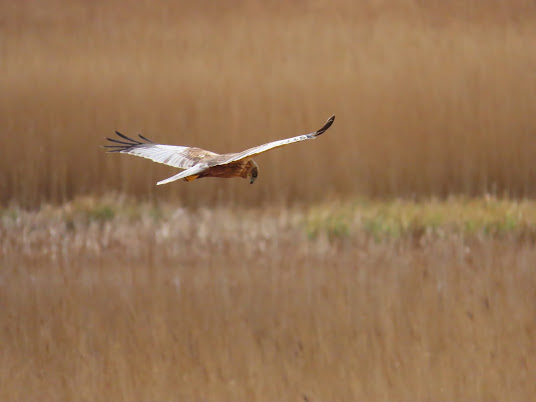Driving to Minsmere, I enter the fringes of the reserve, passing through the extensive woodlands, layered by growths of brown bracken, under the bare branches of the birch trees. And as I pass these it finally feels that I have arrived at Minsmere and my thoughts turn to what birds I would see. For a late winter's day, I was expecting to see wildfowl, and maybe some something else rare. Minsmere has that magic which soon drags you into its green soul.
What a tumultuous day it was at Minsmere, a constant conveyor belt of different weather patterns, rain sleet, hail, and sun. But with the mild winter, thoughts of spring are in the air, and with such a warm season we have had it wont be long until our resident breeding birds start to get more active. But despite all this there were still a lot of winter birds hanging around.
Being the last gasps of winter DUCKS dominated the scene, and today there was a good selection of these waterfowl around, birds starting to move as they gear up for Spring. From a rarity point of view, top billing must go to the pair of SMEW on Island Mere, a beautiful monochrome, black and white male, with a more subdued "red head" female. These are proper winter scarcities, ones birdwatchers are constantly on the look for and luckily being ducks they tend to linger so are quiet easy to catch up with. Island Mere was fairly quiet but also held a WHOOPER SWAN, with two pairs of GREAT CRESTED GREBE also turning up for the breeding season. A SNIPE was also present, as usual asleep in the cut reed area in front of the hide.
From Whin Hill, at the summit that looks down over the reedbeds, four GOOSANDER, a male and three female, were seen in a pool next to Island Mere as well as a further two WHOOPER SWAN. Unfortunately these birds couldn't be seen close up from the Island Mere Hide, so I only had distant views. Around Island Mere and the Bittern Hide, several MARSH HARRIERS were present, two males and a female, although as yet they haven't started to get geared up for the breeding season.
The Scrape was fairly quiet as disturbance from building work extending East Hide caused a lot of disturbance, so most birds were on South and West Scrape. There was a large increase in SHOVELLER, these birds are moving through as Spring migrants, and a pair of PINTAIL were on South Scrape. The Levels were flooded now and were full of birds, mainly TEAL and WIGEON, while a GREAT WHITE EGRET was seen patrolling a dike there.
A sign of spring was shown by the increase in WADER numbers on the Scrape, birds that are quite scarce in winter. Fifty DUNLIN were on South Scrape, as well as two CURLEW. Breeding waders have started to arrive, with around five pairs of OYSTERCATCHERS present, these constantly noisy and hyperactive birds were full of energy, and are a real feature of the Suffolk Coast. Several RINGED PLOVER had also turned up, a bird that likes to nest on the beach, and on the stony islands of the Scrape. Although the lesser yellowlegs had been reported today I didn't see it among all the ducks and tufts of sedges on the Levels.
Aside from the bigger, more obvious wetland birds, the smaller birds were quite active and obvious today. Although it feels like spring, its not quite there yet as a season, and the smaller birds have yet to start singing, it wont start for another few weeks. Around the visitor centre the bird feeders attracted a huge number of birds. Such goodies seen were a NUTHATCH, MARSH TIT and several COAL TITS. The nuthatch was very greedy, constantly returning to the bird table, being a slightly bigger bird it bossed the smaller tits to get prime feeding. I wish I could attract that assortment of birds to the feeders in my garden.
On the Dunes, among a large cover of gorse, a DARTFORD WARBLER, was seen, and though they are present all year, are tricky to see in the spiky cover. And where there are dartfords, there are also STONECHATS as well, with one male present, as usual showing from a perch. From the reedbeds there would explode the song of the CETTI'S WARBLER in various areas, early singers they often start to sing from late December.
A good day's birding at Minsmere, as you would expect. Soon eyes will be turned to spring, when the bird's start to really ramp up. Soon the resident birds will start singing, and soon the birds will start to migrate, and in that season anything is possible, as rarities can turn up anywhere. However today it shows that winter is not quite over, and maybe a surprise may happen over the next month or so.









No comments:
Post a Comment